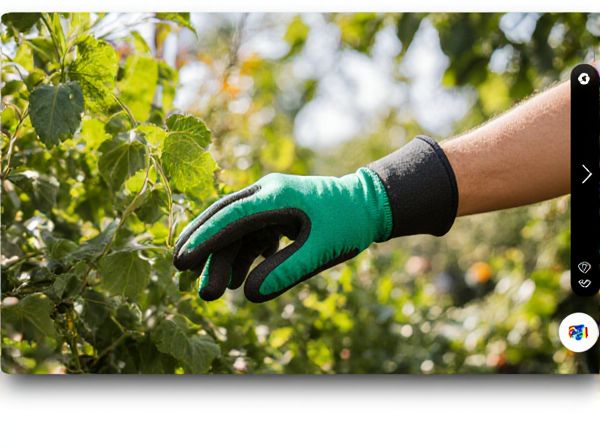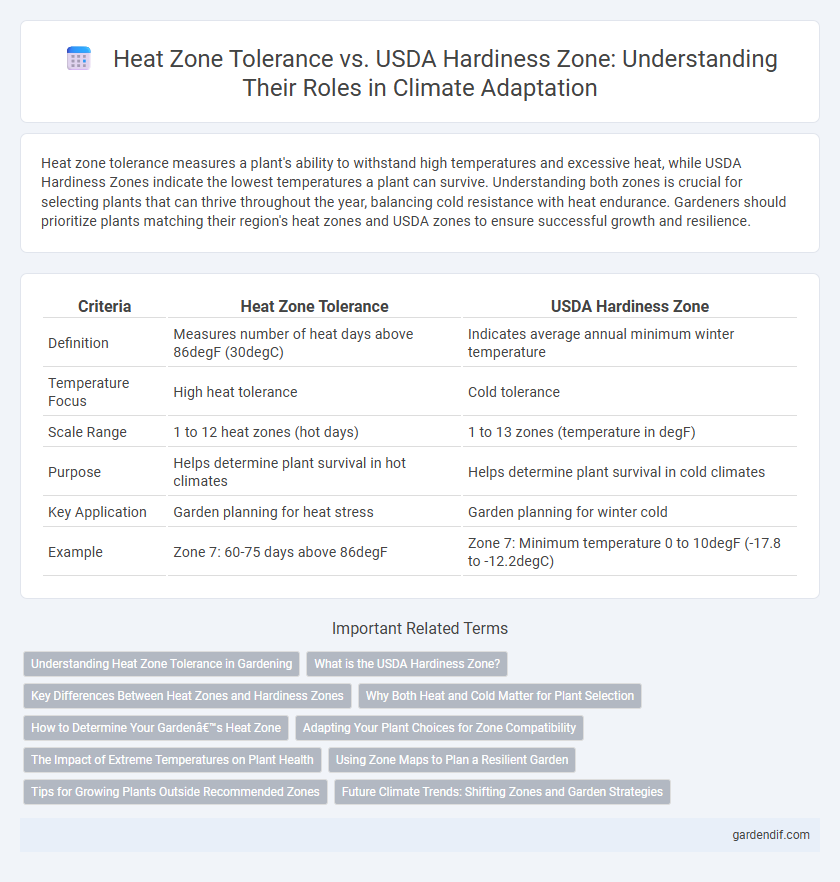
Heat Zone Tolerance vs USDA Hardiness Zone Illustration
Heat zone tolerance measures a plant's ability to withstand high temperatures and excessive heat, while USDA Hardiness Zones indicate the lowest temperatures a plant can survive. Understanding both zones is crucial for selecting plants that can thrive throughout the year, balancing cold resistance with heat endurance. Gardeners should prioritize plants matching their region's heat zones and USDA zones to ensure successful growth and resilience.
Table of Comparison
| Criteria | Heat Zone Tolerance | USDA Hardiness Zone |
|---|---|---|
| Definition | Measures number of heat days above 86degF (30degC) | Indicates average annual minimum winter temperature |
| Temperature Focus | High heat tolerance | Cold tolerance |
| Scale Range | 1 to 12 heat zones (hot days) | 1 to 13 zones (temperature in degF) |
| Purpose | Helps determine plant survival in hot climates | Helps determine plant survival in cold climates |
| Key Application | Garden planning for heat stress | Garden planning for winter cold |
| Example | Zone 7: 60-75 days above 86degF | Zone 7: Minimum temperature 0 to 10degF (-17.8 to -12.2degC) |
Understanding Heat Zone Tolerance in Gardening
Heat zone tolerance measures a plant's ability to endure high temperatures based on the average number of days above 86degF, while USDA Hardiness Zones indicate cold temperature survival levels determined by the lowest winter temperatures. Understanding heat zone tolerance helps gardeners select plants that can thrive in hotter climates, reducing heat stress and improving growth outcomes. Integrating both heat and hardiness zones allows for more precise plant selection tailored to local temperature extremes throughout the year.
What is the USDA Hardiness Zone?
The USDA Hardiness Zone categorizes regions based on their average minimum winter temperatures to guide plant selection and cultivation. It divides the United States into 13 zones, each representing a 10-degree Fahrenheit temperature range, aiding gardeners in choosing plants that can survive local cold conditions. This system helps optimize plant growth and survival by matching species to appropriate cold climate tolerance levels.
Key Differences Between Heat Zones and Hardiness Zones
Heat zones measure the average number of days per year with temperatures above 86degF, focusing on a plant's heat tolerance, while USDA Hardiness Zones categorize regions based on the lowest annual winter temperatures to assess cold resistance. Heat Zone tolerance is crucial for determining a plant's survivability during hot summers, whereas Hardiness Zones guide planting decisions to avoid winter kill. Understanding both zones helps gardeners select plants suited for the full climatic range of their location, optimizing growth and survival.
Why Both Heat and Cold Matter for Plant Selection
Heat zone tolerance measures a plant's ability to survive high temperatures, while USDA Hardiness Zones indicate its capacity to withstand winter cold. Both heat and cold tolerance are crucial factors for selecting plants that thrive throughout the entire year in specific climates. Ignoring either can lead to poor growth, stress, or plant death due to temperature extremes outside their optimal range.
How to Determine Your Garden’s Heat Zone
Heat Zone Tolerance is determined by counting the number of days a region experiences temperatures above 86degF, reflecting plant survival under heat stress, whereas USDA Hardiness Zones are based on the average annual minimum winter temperature. To determine your garden's Heat Zone, consult the American Horticultural Society's Heat Zone Map, which categorizes regions from 1 (less than one day above 86degF) to 12 (more than 90 days above 86degF). Understanding both heat and hardiness zones allows for selecting plants that thrive in local climates, optimizing garden success and resilience amid temperature fluctuations.
Adapting Your Plant Choices for Zone Compatibility
Heat Zone Tolerance measures a plant's ability to withstand high temperatures, helping gardeners select species that thrive during intense heat spells. USDA Hardiness Zones categorize regions by minimum winter temperatures, guiding choices to ensure plants survive cold conditions. Combining these zones allows for precise plant selection, optimizing growth and survival in specific climate conditions by considering both heat and cold tolerance.
The Impact of Extreme Temperatures on Plant Health
Heat zone tolerance measures a plant's ability to survive high temperatures, while USDA hardiness zones indicate minimum winter temperatures a plant can withstand. Extreme temperature fluctuations, including heat waves and cold snaps, cause stress that disrupts cellular function, leading to reduced growth and increased susceptibility to pests. Understanding both heat zone tolerance and hardiness zones is critical for selecting resilient plants and ensuring optimal health in diverse climates.
Using Zone Maps to Plan a Resilient Garden
Heat Zone Tolerance indicates the number of days plants can survive above 86degF, while USDA Hardiness Zone maps average annual minimum temperatures to guide cold tolerance. Using both maps helps gardeners select plants that withstand local heat extremes and winter freezes, ensuring year-round resilience. This combined approach minimizes plant stress and maximizes garden sustainability amid climate variability.
Tips for Growing Plants Outside Recommended Zones
Heat zone tolerance measures a plant's ability to withstand high temperatures, while USDA hardiness zones indicate cold tolerance for winter survival. When growing plants outside their recommended zones, select species with complementary heat or cold resilience and provide microclimate adjustments such as shade cloths or windbreaks. Regular soil monitoring and adaptive watering schedules enhance plant stress resistance, promoting successful cultivation beyond typical zone limits.
Future Climate Trends: Shifting Zones and Garden Strategies
Future climate trends indicate that both Heat Zone Tolerance and USDA Hardiness Zones will shift, with many regions experiencing higher temperatures and altered frost dates. Gardeners must adapt by selecting plants with greater heat tolerance and extending USDA zone considerations to include projected climate data. Employing native species and drought-resistant varieties enhances resilience against unpredictable heat stress and changing seasonal patterns.
Heat Zone Tolerance vs USDA Hardiness Zone Infographic

 gardendif.com
gardendif.com